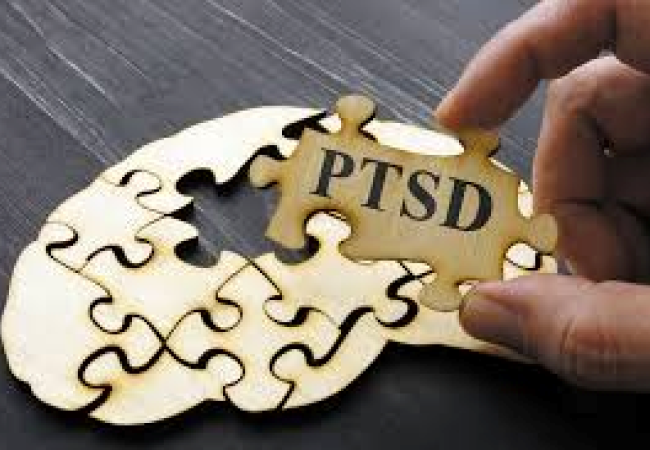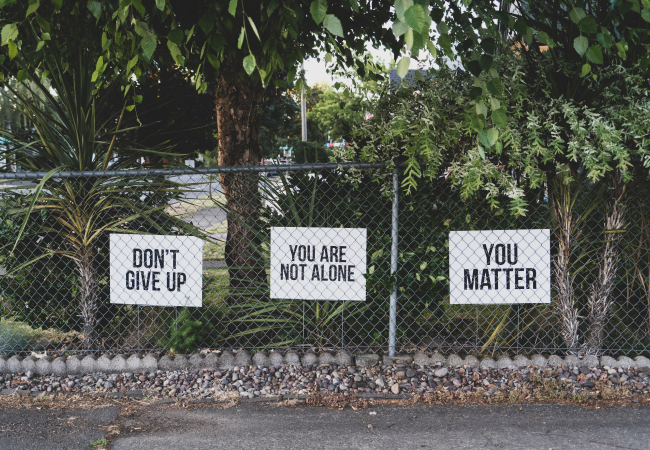What is PTSD?

Intense worry, depression, anger, or guilt that may trigger memories of traumatic events withdrawal, numbness, distressing flashbacks, or physical anxiety. Symptoms of PTSD may appear in the month after the traumatic event, but sometimes they can stay dormant for years. These symptoms last for a long time and interfere with how people cope with everyday life.
Symptoms of Post-Traumatic Stress Disorder:
Everyone is affected differently by PTSD. Symptoms can range from subtle changes in day-to-day life, withdrawal, and numbness, to distressing flashbacks or physical anxiety. Symptoms of PTSD may appear in the month after the traumatic event, but sometimes they can stay dormant for years.
Some symptoms of PTSD include:
• re-experiencing the trauma
• repetitive memories (or flashbacks) that are hard to control and intrude into everyday life
• nightmares/night sweats
• extreme distress caused by reminders of the trauma
• memories or disturbing thoughts that can be prompted by smells, sounds, words or other triggers
Avoidance:
• staying away from places, people or objects that may trigger memories of the traumatic event
• changing a normal routine to avoid triggering memories
• not wanting to talk about or think about the event
• feeling numb
Negative thoughts and mood:
• feeling a sense of hopelessness about the future
• negative beliefs about yourself or the world
• blaming yourself or others unreasonably
• intense worry, depression, anger, or guilt
• not being able to remember the traumatic event
• no longer enjoying favorite activities
• becoming emotionally detached from others
• not being able to experience positive emotions
Increased arousal:
• constant, excessive alertness
• scanning the environment for signs of danger
• being easily startled
• irritable or aggressive behavior
• difficulty sleeping
• poor concentration
Children or teenagers with PTSD may have similar symptoms, but with some differences.
• behave in a destructive, disrespectful, or violent way
• new onset of bedwetting when previously dry at night
• being unusually clingy with parents or caregivers
• acting out the event during play
• forgetting how to talk
• distressing dreams
• being more irritable, angry, or aggressive — such as having extreme temper tantrums
• having problems with concentration
• not being able to sleep
A teenager may experience any of the adult symptoms but may be more likely to:
• have a desire for revenge
• behave in a destructive, disrespectful, or violent way
• increase risk-taking behavior
Although a relationship break-up or losing a job can feel devastating, these are not the kinds of events that usually cause PTSD.
Anyone can develop PTSD, but some people are at greater risk. There is a mixture of reasons explaining why some people develop PTSD while others do not.
Risk factors for developing PTSD include:
• repeated trauma, such as living in a war zone for a long time
• having had a mental illness in the past, like anxiety or depression
• a history of trauma or abuse in early childhood
• experiencing very severe trauma
• not having enough support afterwards
• not having enough support afterward, such as the loss of loved ones, a home, or a job

PTSD is not the only mental health disorder caused by experiencing traumatic events, and depression and anxiety disorders may be just as common. Depression, generalized anxiety, PTSD, and agoraphobia are the most common disorders that can be caused by traumatic events.
A regular physician will do a mental health assessment. This means they will ask about current symptoms, history, and family history. They may do a physical examination to check that there are no other reasons for the symptoms. The doctor may refer to a psychiatrist or psychologist. They will ask how long, how often, and how intense the symptoms are, and what happened during the triggering event.
For PTSD to be diagnosed, the symptoms need to be severe enough to interfere with someone’s ability to function at work, socially, or at home. A full diagnosis cannot be made until at least 6 months after the trauma. Often a diagnosis can come as a relief for someone who has been suffering debilitating symptoms because it provides an explanation and a basis for beginning treatment.
Up to 8 in 10 people with long-standing PTSD develop other anxiety disorders, depression, and/or substance abuse. Coping by trying to block out memories with substance abuse can lead to addictions months after the trauma. Although, often a diagnosis can come as a relief for someone who has been suffering debilitating symptoms because it provides an explanation and a basis for beginning treatment.
A regular physician will do a mental health assessment. This means they will ask about current symptoms, history, and family history. They may do a physical examination to check that there are no other reasons for the symptoms. The doctor may refer to a psychiatrist or psychologist. They will ask how long, how often, and how intense the symptoms are, and what happened during the triggering event.
PTSD is not the only mental health disorder caused by experiencing traumatic events, and depression and anxiety disorders may be just as common. Depression, generalized anxiety, PTSD and agoraphobia are the most common disorders that can be caused by traumatic events.
How is PTSD diagnosed?
A regular physician will do a mental health assessment. This means they will ask about current symptoms, history, and family history. They may do a physical examination to check that there are no other reasons for the symptoms. The doctor may refer to a psychiatrist or psychologist. They will ask how long, how often, and how intense the symptoms are, and what happened during the triggering event.
Up to 8 in 10 people with long-standing PTSD develop other anxiety disorders, depression, and/or substance abuse. Coping by trying to block out memories with substance abuse can lead to addictions months after the trauma. Although, often a diagnosis can come as a relief for someone who has been suffering debilitating symptoms because it provides an explanation and a basis for beginning treatment.
Complications of PTSD:
Up to 8 in 10 people with long-standing PTSD develop other anxiety disorders, depression and/or substance abuse. Coping by trying to block out memories with substance abuse can lead to addictions.
• grieving for a friend, a spouse, or your partner PTSD can prevent people from performing properly at work and make them isolated from relatives and friends. It can put great stress on families. This is why early support and treatment are essential.
Why do people feel lonely or isolated?
You can feel lonely or isolated for many reasons even when other people are around you. Some reasons you might feel lonely or isolated include:
• living alone or lacking close family around you
• grieving for a friend, a spouse, or your partner
• grieving for a friend, a spouse, or your partner
• retiring from work or changing schools or jobs
• living away from home for the first time
• being unemployed
• feeling worried or stressed
• finding it difficult to meet new people
• having a language or cultural barrier or being away from your culture of origin
• being bullied
• feeling unsure about your sexuality
• having a mental health problem, such as depression, anxiety, or a physical disability
How can loneliness and isolation affect my health?
Feeling connected to others is important for our mental and physical wellbeing and can protect against anxiety and depression. If you feel alone or socially isolated for a long time, you might experience physical or mental problems or do things that are not in your best interest.
• Physical symptoms — such as headaches, feeling ill, having pains, feeling tired, having sleep problems, or lacking motivation.
• Mental health conditions — such as depression, feeling anxious, having panic attacks, or feeling paranoid.
• Low energy — feeling tired or not being motivated.
• Sleep problems — not being able to get to sleep, stay asleep, or waking up a lot.
• Diet problems — such as putting on weight, losing weight, or losing your appetite.
• Negative feelings — such as feeling worthless or hopeless or thinking about suicide.
• Substance abuse — such as drinking a lot of alcohol, misusing medicines, or taking drugs.
What can help?
You can help to overcome loneliness and isolation and improve your life by:
• Connecting with family and friends — visit, phone, email or use video technology.
• Connecting with communities online — join a game where you can chat with people.
• Getting out of the house — go shopping, exercise, join a club, or enroll to study.
• Volunteering — meet new people to feel connected and valued.
• Getting a pet — talking about pets is a great conversation starter when you meet people. Animals as pets or even a service dog for someone with PTSD or another phycological disorder may qualify for a service dog. Pets or service dogs can improve your physical and mental health.
In closing: There are so many things that can cause someone to be diagnosed with PTSD. There are so many that go undiagnosed for fear of becoming labeled when they are seeking the professional help they need. No one should ever feel ashamed for seeking help from a professional.
As mentioned above in the breakdowns so many are under the impression that only Adults are subject to post-traumatic stress disorder, when in all reality that is simply NOT the case at all. Any human being regardless of age can experience trauma of any sort that can lead to PTSD. Some cases are merely more severe than others but not that anyone is any more important than the other by no means.
Today has been an especially important subject for my family. We cannot express enough that if you are experiencing or know someone to be a friend or a good listener, be patient if that someone you know may or may not want to you right away. PTSD does not happen overnight. The trauma may have but the feeling that comes along with that trauma is built over time and so deep it gets buried over time when not dealt with properly.
Post-traumatic stress disorder or also known as PTSD is a disorder that may result when individual lives through or witnesses an event in which he or she believes that there is a threat to life or physical integrity and safety and experiences fear terror, or helplessness. The feelings last for a long time and interfere with how people cope with everyday life.


Leave a Reply